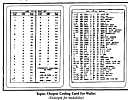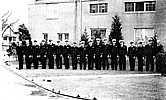ATLAS AND THE EARLY DAYS OF COMPUTERS
By Harlan Snyder, LCDR USNR, Ret.Some personal reminiscences about ATLAS Project 13, and the subsequent Engineering Research Associates (ERA) 1101 Computer and the Naval Computing Machine Laboratory (NGML) at St. Paul, Minnesota in 1949 and 1950.
As a newly minted Ensign from the Navy V-12 and NROTC program at Iowa State College, I was ordered in the summer of 1948 to the Navy Department in Washington, D.C. to a function designated as OP-20 in Naval Communications. At the time we were known as a part of Communications Supplementary Activity (CSA), then for a while Armed Forces Security Agency (AFSA), and finally NSA (National Security Agency).
My studies had been in Communications/Radio Engineering and Russian language. I was also a radio amateur. After checking in at the old Navy buildings on the mall I was sent to 3801 Nebraska Avenue for training and clearance with several others. Some of our routine duties included the daily incineration of burn-bag material; escort of hundreds of pounds of punched cards to a location in Georgetown where they were reduced to pulp; and courier duty to the Army Security Agency at Arlington Hall, the State Department and certain foreign embassies. While on courier or escort duty we were armed with a Colt .45 service pistol and were accompanied by a senior petty officer as driver. Upon clearance I was to be assigned to the ATLAS project which was underway at NCML. The Naval Computing Machine Laboratory at 1902 W. Minnehaha Avenue in St. Paul, was part of an industrial site which had originally been a factory for heating radiators and then converted to glider manufacturing in WWII. NCML shared the site with ERA.
(The original Naval Computing Machine Laboratory had been at National Cash Register in Dayton, Ohio during WWII as part of the Navy Communication Supplementary Activity (CSA) and OP-20.) I transferred to St. Paul in April of 1949 along with Ensign Roy Howard, who was assigned to another project. My orders were to learn the system and to be responsible for maintenance and training after installation back at Nebraska Avenue.
Upon arrival at St. Paul I found that the system design was essentially complete and that "breadboarding" and prototyping were well along. By the summer of 1950 final de-bugging and testing were underway.
ATLAS/1101/Project 13 was a large-scale, general purpose octal architecture computer/system funded through the Navy Bureau of Ships. It was designed and built by Engineering Research Associates of St. Paul, (which also had a Washington D.C. office.) Design and build took place from 1947-1950, under technical direction of OP-20: Dr.'s Joe Eachus, Howard Campaigne, and George Cramer, all mathematicians. The contract price was rumored to be $700,000. It contained some 2,000 vacuum tubes, a large magnetic drum storage, paper tape reader and punch and IBM Electromatic typewriter for I/O. Tubes were in pluggable modules, some twenty tubes per module. There were some five cabinets, all painted battleship gray, perhaps five feet in height, and connected together with a central operator's console for a total length of some 40 feet. Cooling was by a chilled water heat exchanger to an air plenum under the system. At Nebraska Avenue the chilled water control valve servo caused electrical noise interruption from time to time until identified and corrected by the facility/building personnel.
Dr.'s Eachus and Campaigne made periodic visits to St. Paul and I remember in 1950, when the system was more or less operational, Joe ran a program which calculated the sine function and plotted it on the output typewriter. We were all elated!
During my assignment in St. Paul there were approximately twenty navy personnel, including commissioned officers, warrant officers, and senior petty officers. The commanding office was Capt. Philip Creasor, later relieved by Capt. Earl Hawk. At least two of the officers were from the original "OTRG" gang - LCDR LeRoy Lankford, and CW04 Rudy Soland. (At the time I knew nothing of OTRG and don't recall it ever being mentioned). The number of civilian employees at ERA for NCML projects was perhaps 100 or so. ERA also had other business and employees not involving navy contracts.
The number 1101 (binary 13) came from the Navy project number 13, as there were several different projects, each identified by a decimal number and code name. One of the large storage drum projects was called "SATYR". Other NCML projects included one of the first TTY demodulators using a Lissajou figure-tuning display. The first commercial version of ATLAS by Remington Rand (after purchase of ERA) was called the 1101 and became the precursor of a family of machines, i.e. 1101-1108.
ERA personnel included Project Engineers Frank Mullaney and Jack Hill. Frank had been a television engineer at KSTP, St. Paul; Jack was from 3M. Other engineers and technical staff were Warren Burrell (who years later made headlines in a Federal age discrimination law-suit), Arnold Cohen from the University of Minnesota and RCA, Arnie Hendrickson, Sid Rubens (magnetic drums), Dave Noble (who had been at the original NCML in Dayton, Ohio in WWII and later was a key inventor of the floppy disk at IBM), Joe Keller (who had been at RCA and was experimenting with CRT "high speed" digital storage), George Hardenbergh and Bill Keye. Several eventually went on with Bill Norris (who was in upper ERA management and who had also been at Dayton) after Remington Rand took ownership to later found the Control Data Corporation as has been described elsewhere.
ATLAS was shipped from St. Paul in Pullman and Railway Express cars, with armed Naval personnel escort, to the Bureau of Ships/NSS (Nebraska Avenue) in November 1950. The individual ATLAS cabinets were loaded on a spur track which came into the ERA premises. In Washington it was transferred by truck to Nebraska Avenue, installed, and brought up and running by ERA personnel in less than two weeks. I had returned to Washington at this time and remained with ATLAS doing training and maintenance until transferring to destroyers at the end of 1951. Upon completion of my destroyer tour (USS Fred T. Berry, DDE 858) I transferred to the Naval Reserve and after two years of travel and study in Europe taught antisubmarine warfare at the San Jose, California Reserve Training Center. At the time we had a very active Naval Security Group but all officer billets were full.
Back to ATLAS: Assembler language had not been "invented". Coding was in binary(!), and I/O had to be coded character by character. As there was no operating system, the operations group queued up on each shift for run time. There were a lot of "expletives deleted" as each program was run for the first few times. An attempt was made in spare evening time to calculate (pi) to several hundred places, however it was eventually abandoned as storage of intermediate results was difficult. (I'm not sure of the algorithm used - as I recall, it made use of an arctangent formula, but "fast" convergence was required. There was concern that release of any results could be a security problem as it would raise questions as to how such a result had been calculated, and by whom, even though we were not trying to beat the latest value for Pi.)
At the time ATLAS may have been the most powerful fully operational general purpose computer in the world. It ran "24/7" most of the time. "Competition" (which was snickered at by some of us) included the Harvard Mark I, Remington Rand Univac, SEAC, IBM 604, and others. Of these, only the Univac reached commercial status as a system. (The IBM 604 was a punched card calculator).

| ERA ATLAS 1101 Input/Output Coding Card for Wallet
(Enlarged for readability) |
ATLAS reliability was very good. Tube failures were insignificant, contrary to many dire predictions. (It was part of my duty to keep track of tube failures.) Some Western Electric tube types had almost no failures, while the 2D21 thyratrons had the poorest reliability. However, I don't remember that we ever had a tube fail in normal operation. Low filament voltage tube-testing was utilized extensively, and we were probably able to avoid most tube fails by this. Head adjustments on the magnetic drum were critical and properly read signal amplitude was verified with an oscilloscope. Spare tracks were available in cases of track damage. Lt. (jg) Charlie Jarrett invented a pluggable interlacing scheme which significantly speeded up certain programs. Several different interlaces (for drum addressing) were used. Operational programs specified an interlace which had been determined to be optimal in run time for the particular program. Bill May, Don Ream and many others were in the operations crew at Nebraska Avenue. Reserves (Navy) were being recalled since the outbreak of the Korean war in June. Many, like Don Iacaboni, went home in civilian clothes one day, and came back the next in uniform - doing the same job. One of the up and coming enlisted people, Charles Blair, was assigned to ATLAS.
The system was displayed to visiting dignitaries from time to time, including the famous mathematician, John Von Neumann and others from academe, and Los Alamos. (the 1101 was an example of "von Neumann" system architecture where sequences of instructions/commands are intermixed with data).
According to colleagues at the time, after service at NSA ATLAS would up in NATO and was at an ASW facility in Italy (Leghorn) about 1965. I saw an advertisement for sale of what appeared to be ATLAS in the European edition of the New York Herald Tribune about 1966 or 1967.
References:
- Magnetic Recording, The First 100 Years; Daniel, Mee, Clark; IEEE Press 1999, in particular Chapter 16.
- Remington Rand/Univac literature on 1100 series of computers, 1101-1108.
- A few Good Men from Univac; Lundstrom; The MIT Press; 1987.
- Annals of the History of Computing, Vol. 1, Number 2, October 1979 ("The Birth of ERA").
Looking Ahead ... in Hindsight
